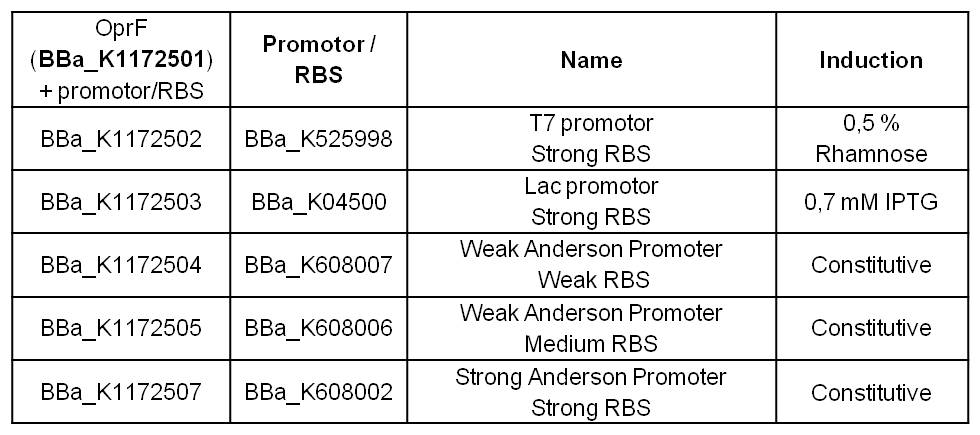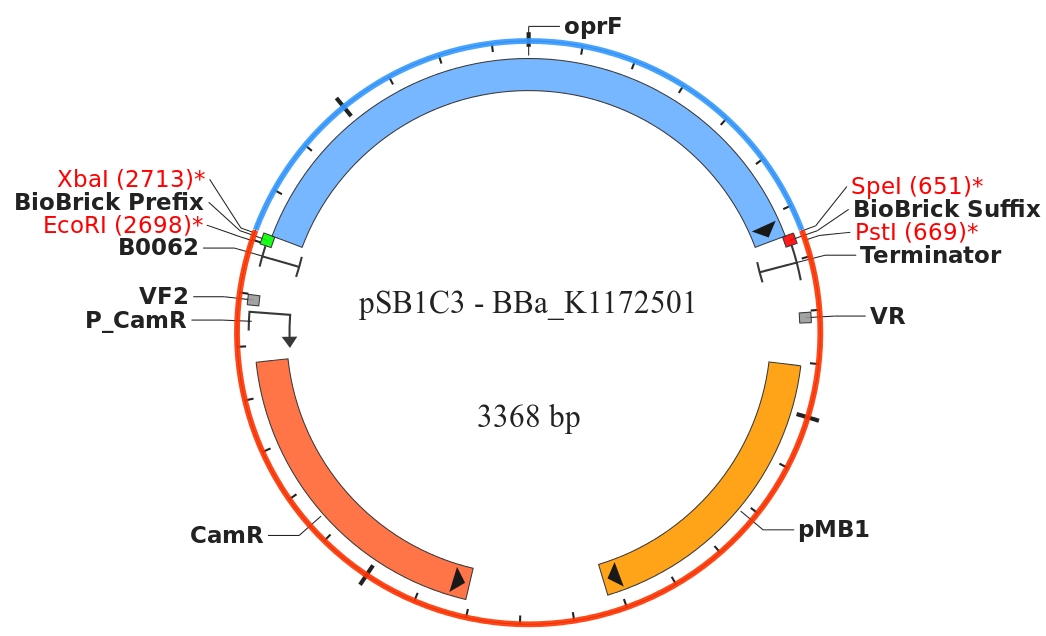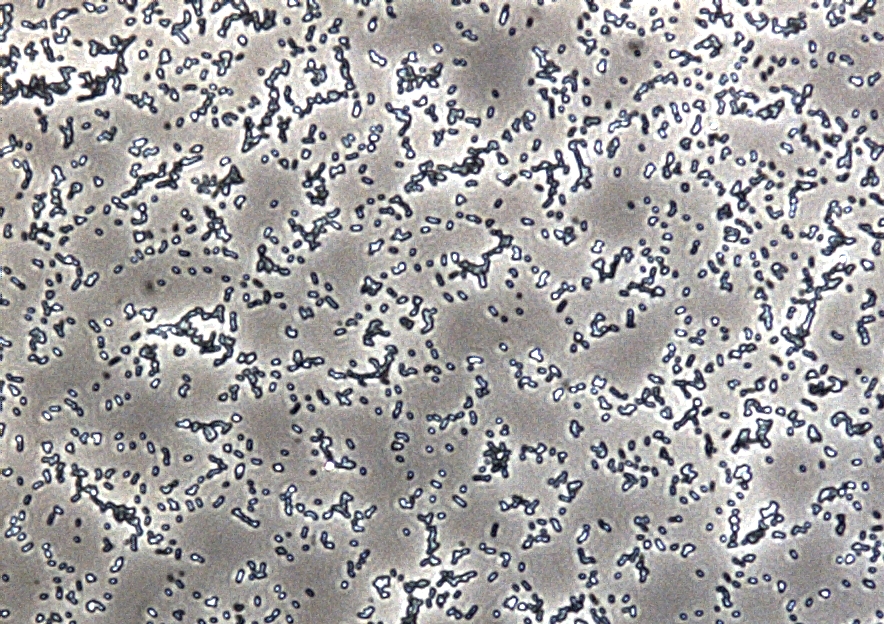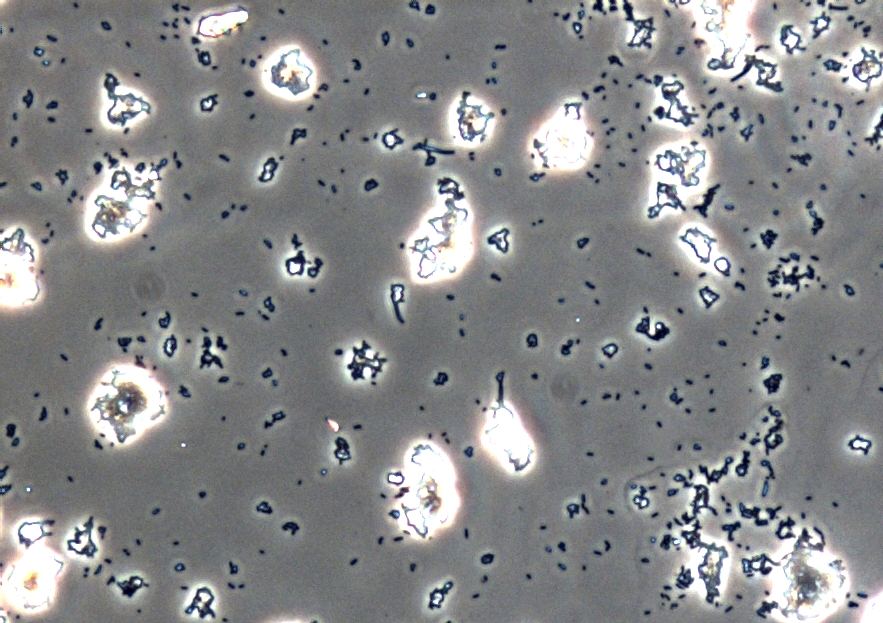Team:Bielefeld-Germany/Project/Porins
From 2013.igem.org
Porins
Overview - Porin OprF
By heterologous expression of the pore-forming transmembrane-protein (or porine) OprF from Pseudomona fluorescens a further optimization of the E. coli membrane will be achieved. E. coli possesses several own porines, for example OmpF and OmpC. But these naturally occurring porines are only permeable for molecules smaller than 600 Da, which decreases the range of usable mediators significantly. Opposed to that, porine OprF from P. fluorescence forms one of the biggest known pores in the outer bacterial membrane with a permeability of up to 3000 Da, thus improving the electron shuttle mediated extracellular electron transfer (ETT) and enabling the usage of alternative mediators such as riboflavin (vitamine B2).
Theory
- Theory for OprF outer membrane porin.
Genetic Approach
- The OprF gene from Pseudomonas fluorescens was cloned and heterologously expressed in Escherichia coli KRX under the control of different promoters (Table 1).
Results
Overview
- Upon the expression of the outer membrane porin protein OprF, the morphology and physicochemical characteristics of the E. coli surface were measured. SDS-PAGE combined with MALDI-TOF MS/MS, different membrane permeability assays (NPN and ONPG), a hydrophobicity assay and Atomic Force Microscopy (AFM) characterize OprF BioBrick <bbpart>BBa_K1172501</bbpart>.
SDS-PAGE and MALDI-TOF
- OprF could been detected with SDS-PAGE. Protein isolation of the outer membrane porin OprF by Release of periplasmic protein fraction from E. coli by cold osmotic shock using Cell fractionating buffer 2.3 was successful.
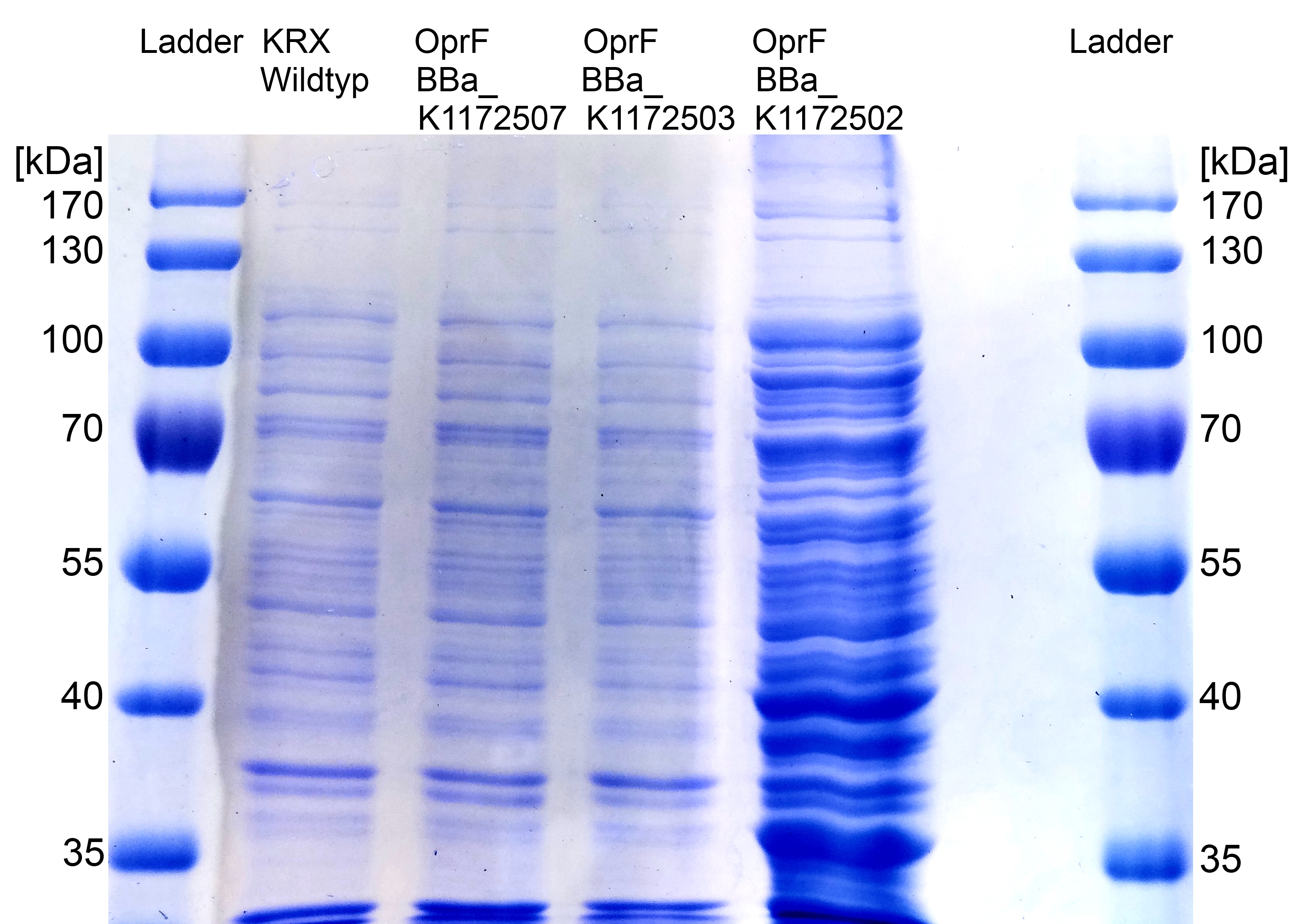
Figure 2: SDS-PAGE with Prestained Protein Ladder from Thermo Scientific as marker. Comparison of protein expression between Escherichia coli KRX wild type and Escherichia coli KRX with <bbpart>BBa_K1172502</bbpart>, <bbpart>BBa_K1172503</bbpart> and <bbpart>BBa_K1172507</bbpart> after periplasmic protein fractioning with Cell fractioning buffer 2.3.
- The SDS-PAGE shows a significantly higher protein concentration for E.coli with OprF and T7 promoter (<bbpart>BBa_K1172502</bbpart>). It seems to be that the higher membrane permeability (shown with NPN and ONPG uptake assay) allows a better release of membrane proteins by 0.2 % SDS. Nevertheless, we can see a strong overexpression band at the expected OprF size of about 36 kDa for <bbpart>BBa_K1172502</bbpart>, which is equated with a strong expression and overproduction of OprF.
- Furthermore we were able to identify the overexpressed outer membrane porin (Figure. 2) with MALDI-TOF MS/MS.
- Tryptic digest of the gel lane for analysis with MALDI-TOF could examine the outer membrane porin with a Mascot Score of 222 against bacteria database.
Hydrophobicity (Hexadecane) - Assay
- The heterologous expression of the outer membrane porin OprF will enhance the hydrophobicity of cell membrane. The outward-facing side groups on each of the β-strands of the OprF monomer are hydrophobic. Therefore a positive expression should be visible by an increase in hydrophobicity.
- An increasing hydrophobicity of cell membrane changes the physicochemical properties of the cell. This could effect for example the cell-electrode interaction. Therefore, we investigated the cellular surface characteristic by comparing Escherichia coli KRX wildtyp with Escherichia coli KRX with <bbpart>BBa_K1172502</bbpart>, <bbpart>BBa_K1172503</bbpart>, <bbpart>BBa_K1172504</bbpart>, <bbpart>BBa_K1172505</bbpart> and <bbpart>BBa_K1172507</bbpart> (Table 2 and Figure 3).
- The OprF strain shows an increasing affinity to hexadecane with increasing promotor strength in comparison to the Wildtyp. OprF with T7 promotor (<bbpart>BBa_K1172502</bbpart>) shows the maximal hydrophobicity which was three times higher than affinity to hexadecane of the Wildtyp.
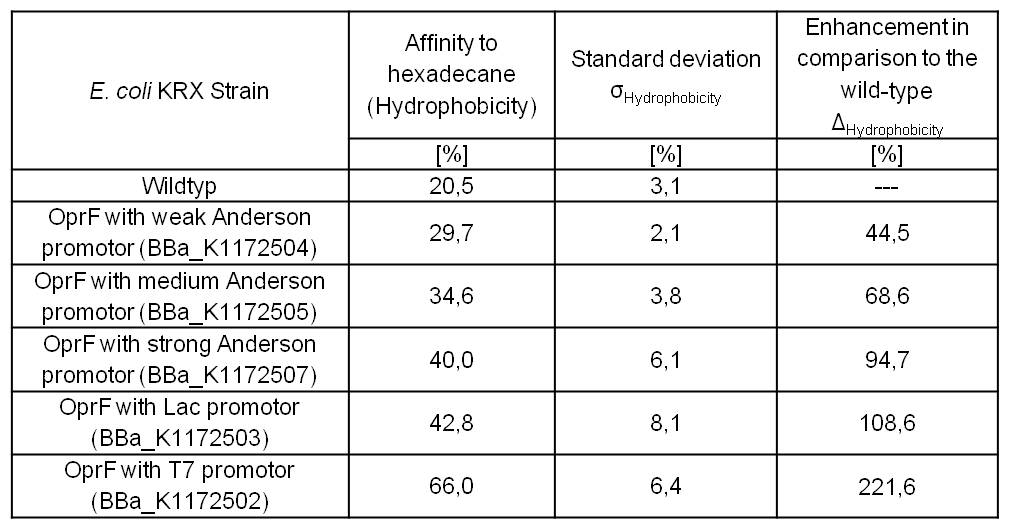
Table 2: Results of the Hexadecane-Hydrophobicity-Assay. Comparison of protein Hydrophobicity between Escherichia coli KRX wild type and Escherichia coli KRX with <bbpart>BBa_K1172502</bbpart>, <bbpart>BBa_K1172503</bbpart>, <bbpart>BBa_K1172504</bbpart>, <bbpart>BBa_K1172505</bbpart> and <bbpart>BBa_K1172507</bbpart>. Affinity to hexadecane (Hydrophobicity) with standard deviation and enhancement in comparison to the wild-type is shown.
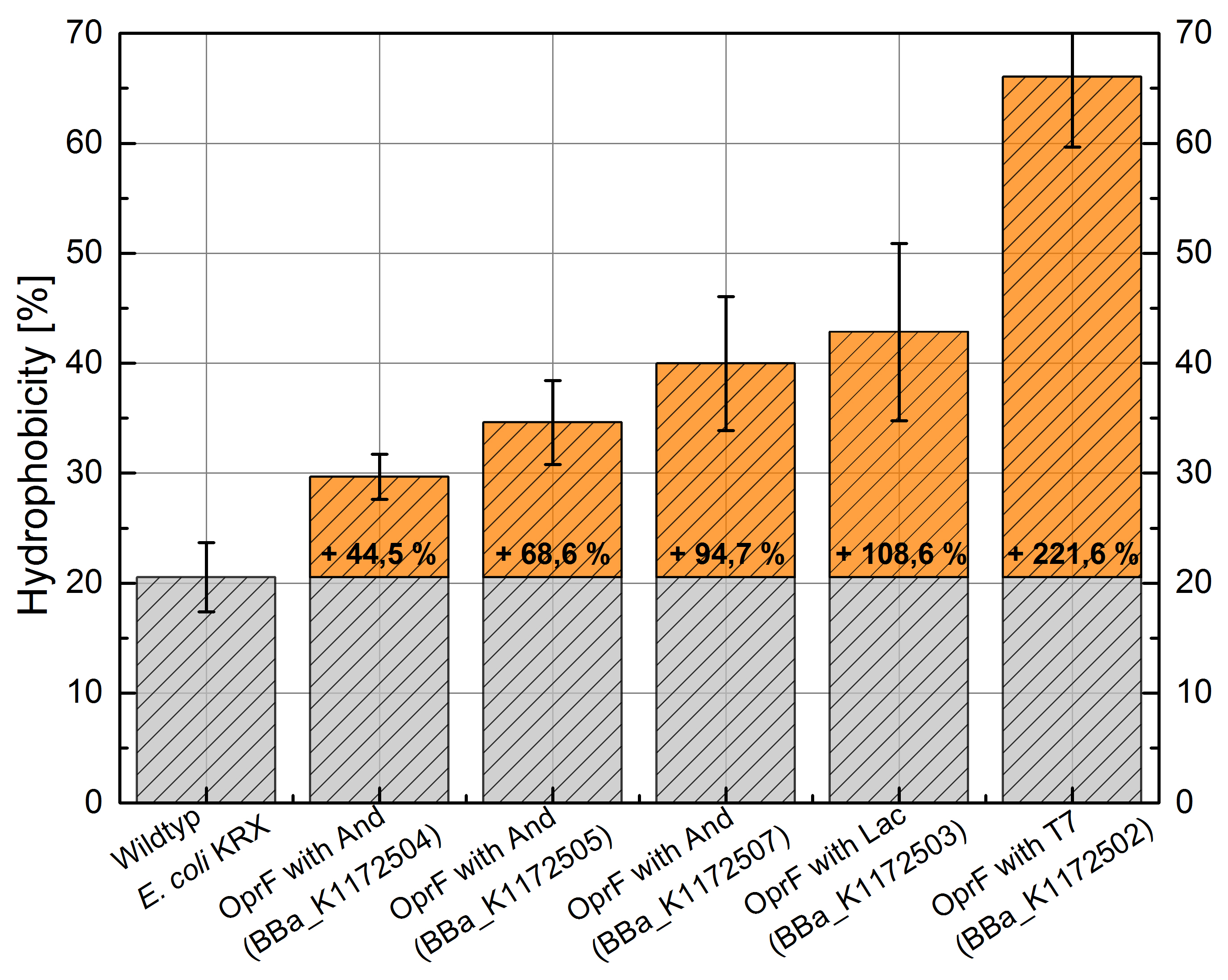
Figure 3: Results of the Hexadecane-Hydrophobicity-Assay. Comparison of protein Hydrophobicity between Escherichia coli KRX wild type and Escherichia coli KRX with <bbpart>BBa_K1172502</bbpart>, <bbpart>BBa_K1172503</bbpart>, <bbpart>BBa_K1172504</bbpart>, <bbpart>BBa_K1172505</bbpart> and <bbpart>BBa_K1172507</bbpart>. Affinity to hexadecane (Hydrophobicity) with standard deviation and enhancement in comparison to the wild-type is shown.
- The enhanced hydrophobicity of OprF-strains indicates a successful expression of the outer membrane porin in Escherichia coli. Such an increased hydrophobicity on the outer membrane caused by the expression of OprF will lead to an increase in the cellular adhesion to the surface of the carbon anode and an enhancement of direct electron transfer from Escherichia coli to the electrode.
Membrane permeabilty assays
NPN uptake assay
- Besides testing the outer membrane hydrophobicity for physicochemical characterization of the E. coli surface, we measured the membrane permeability by NPN uptake assay for outer membrane morphology characterization (Helander and Mattila-Sandholm, 2000).
- NPN is a very suitable chemical for measuring the membrane permeability of cells. An increasing NPN fluorescence intensity indicates an enhanced NPN uptaking by the outer membrane and enhanced membrane permeability (Loh et al., 1984).
- Figure 8 shows a higher fluorescence emission and therefore higher membrane permeability with increasing promotor strength for OprF strains in comparison to Escherichia coli KRX wildtyp.
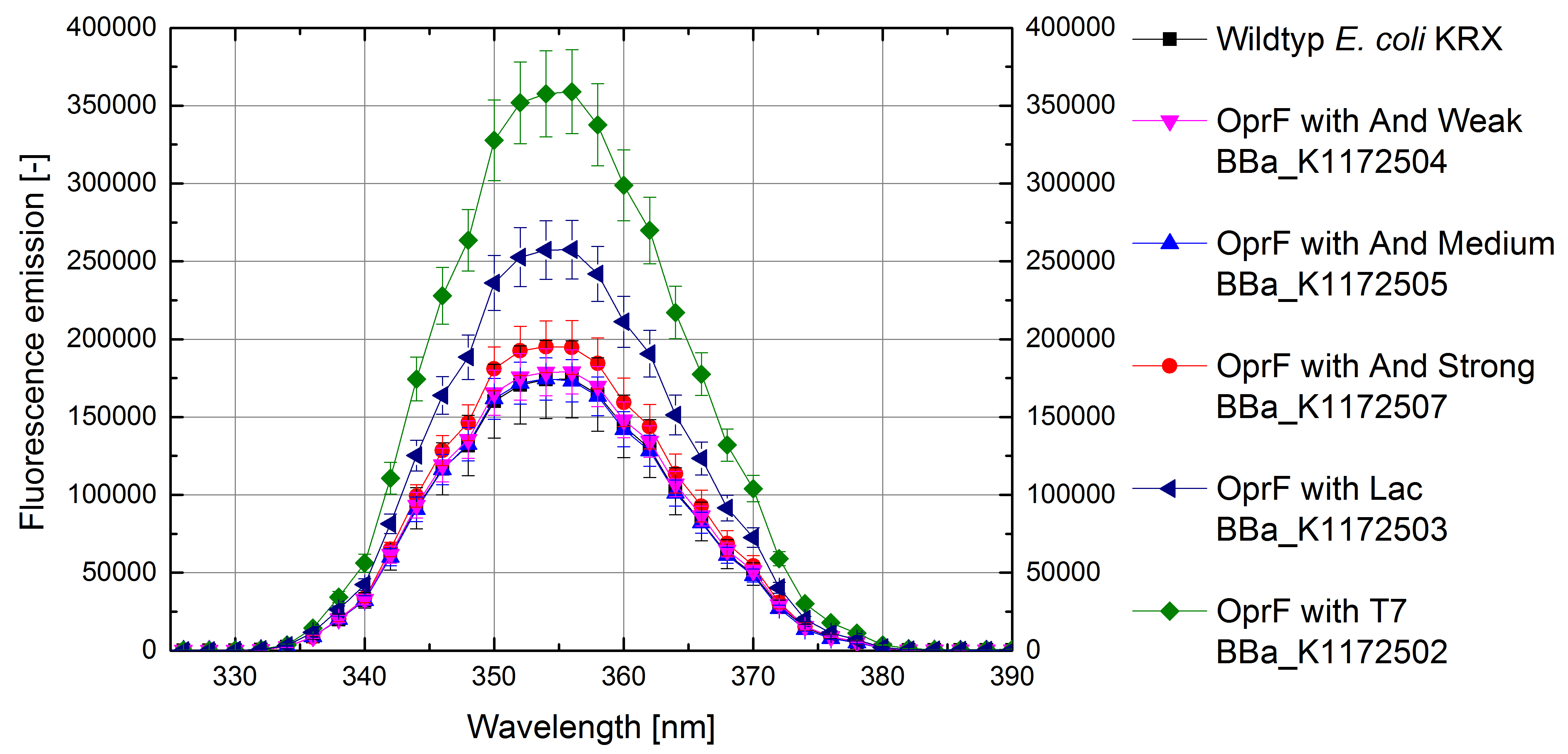
Figure 4: Results of the NPN-uptake-assay. Comparison of fluorescence emission between Escherichia coli KRX wild type and Escherichia coli KRX with <bbpart>BBa_K1172502</bbpart>, <bbpart>BBa_K1172503</bbpart>, <bbpart>BBa_K1172504</bbpart>, <bbpart>BBa_K1172505</bbpart> and <bbpart>BBa_K1172507</bbpart>. Excitation at 355 nm with fluorescence emission scan from 320 up to 390 nm wavelength and with standard deviation.
- Escherichia coli with heterologous expression of the outer membrane porin OprF shows more efficient NPN uptaking than the Escherichia coli KRX Wildtyp, suggesting an increasing membrane permeability with increasing promotor strength. E. coli with T7 promotor (<bbpart>BBa_K1172502</bbpart>) shows the maximal membrane permeability with 100% enhanced permeability in comparison to Escherichia coli KRX Wildtyp. The weak Anderson promoters seem unsuitable for heterologous expression.
ONPG assay
- Another way of characterizing the outer cell membrane can be achieved by ONPG assay. ONPG assay measures the membrane permeability by whole-cell lactase enzyme activity (Zhou et al., 2010).
- Electron shuttle-mediated electron transfer (EET) determines the transport efficiency of electron shuttles across the cell membrane. With NPN uptake assay we were able to quantify the transport efficiency of chemical molecules across the cell membrane. ONPG assay (Whole-cell β-lactase enzyme activity assay) can show furthermore the diffusion of ONPG hydrolytic product out of the cell membrane, which quantifies not only uptaking of chemical molecules, but also the hydrolytic product secretion. With ONPG assay we are able to observe diffusion processes in and out of the cell membrane.
- Due the fact that heterologous expression of OprF in Escherichia coli has no impact on the expression of β-lactase, we can assume that the β-lactase activity of Escherichia coli KRX Wildtyp and Escherichia coli KRX with OprF expression plasmid is identical. All in all, the ONPG assay provides significantly more information than the NPN uptake assay.
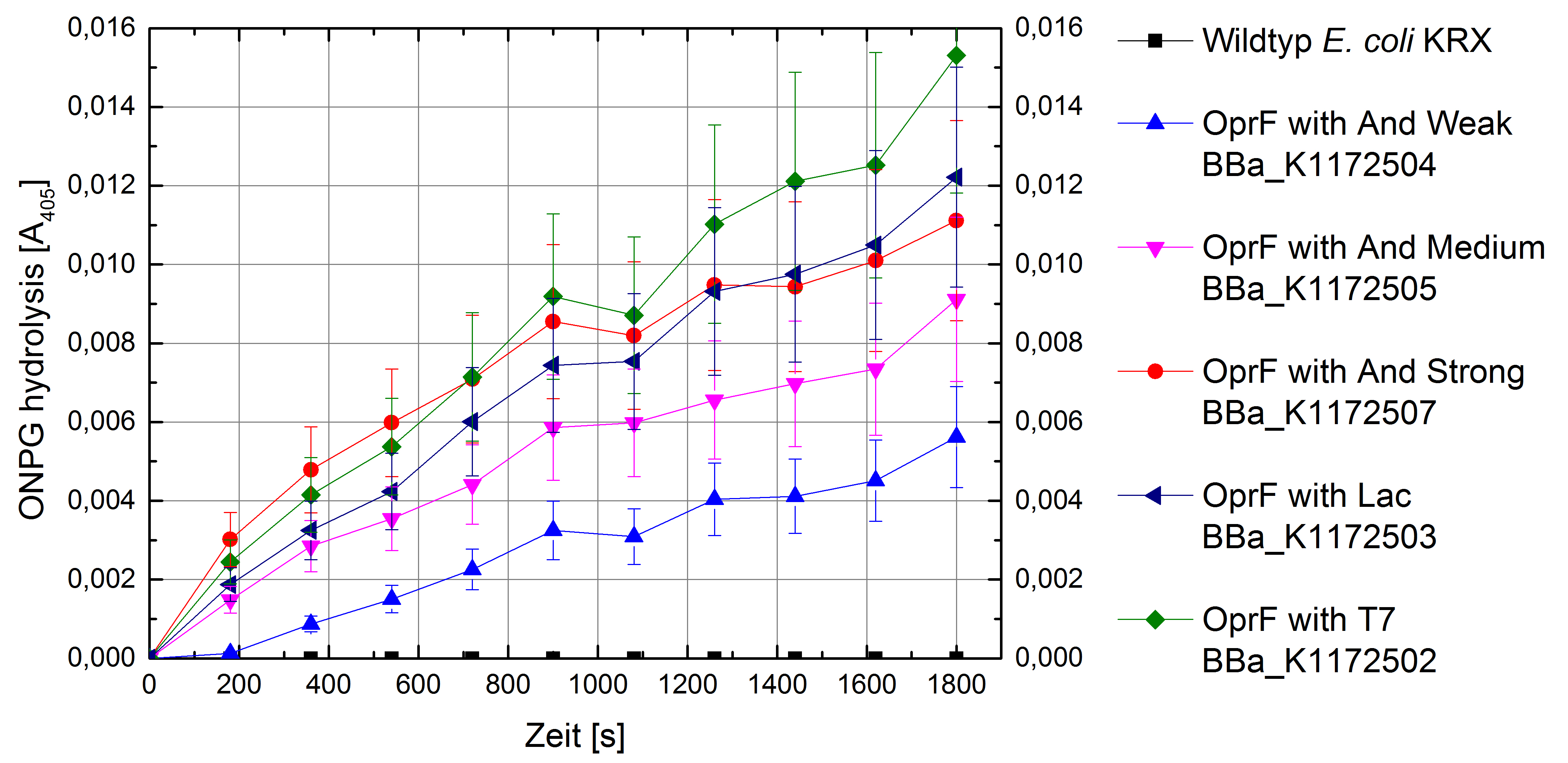
Figure 5: Results of the ONPG-uptake-assay. Comparison of ONPG hydrolysis between Escherichia coli KRX wild type and Escherichia coli KRX with <bbpart>BBa_K1172502</bbpart>, <bbpart>BBa_K1172503</bbpart>, <bbpart>BBa_K1172504</bbpart>, <bbpart>BBa_K1172505</bbpart> and <bbpart>BBa_K1172507</bbpart>. Absorbance at 405 nm wavelength with standard deviation is shown.
- The ONPG hydrolysis rate by β-lactase is much higher for Escherichia coli KRX with OprF plasmids in contrast to Escherichia coli KRX Wildtyp. Whereas we couldn’t observe any hydrolysis activity for Wildtyp. Escherichia coli KRX with OprF plasmids shows a much faster ONPG hydrolysis rate with increasing promotor strength and a maximal rate for Escherichia coli KRX with T7 promotor (<bbpart>BBa_K1172502</bbpart>), which is 30 times higher than Wildtyp hydrolysis rate.
- In summary we can say that the heterologous expression of OprF from Pseudomonas fluorescens in Escherichia coli significantly improves the membrane permeability. NPN and ONPG assay show correlating results. Escherichia coli outer membrane permeability is enhanced with increasing promotor strength for OprF expression. The Wildtyp shows only a weak uptake rate of chemical molecules (NPN) but no product secretion as quantified with ONPG assay. Therefore, Wildtyp is not suitable for a usage in the MFC. Whereas membrane optimized Escherichia coli with OprF shows great diffusion processes in and out of the cellular membrane, indicating a great optimization of electron shuttle-mediated electron transfer (EET) to the anode and increasing current production.
Atomic Force Microscopy (AFM)
- In addition to morphology and physicochemical characterization of the Escherichia coli outer membrane, we wanted to visualize the surface. The technique of choice for this is Atomic Force Microscopy (AFM). After cell preparation we were able to get AFM pictures of E. coli surface with the help of the working group of Prof. Dr. Dario Anselmetti, with special help from Dr. Volker Walhorn. Thank you very much for your help!
- Microscopy of AFM glass layer after cell preparation and before AFM measurement shows the different cell properties at the same image enlargement of the microscope and the same number of cells. Escherichia coli KRX with T7 promotor (<bbpart>BBa_K1172502</bbpart>) shows a clustering of cells, whereas wild-type forms a monolayer. The increased hydrophobicity of the cell surface is already visible even with an ordinary light microscope.
Conclusion
- Cell membranes are protective layers which are crucial for physiology of the bacteria. In consideration of the Microbial Fuel Cell, membrane is also a barrier which decreases mediator and thus electron exchange between bacteria and anode. With heterologous expression of the outer membrane porin OprF from Pseudomonas fluorescens in Escherichia coli we are able to enhance membrane permeability. With this optimized cell membrane surface we generate an efficient electron shuttle-mediated EET with decreased limitation of EET by membrane barrier. In contrast to a perforation of the membrane with chemicals, cell viability is maintained with OprF expression (Liu et al., 2012). Besides improvement of EET, enhanced hydrophobicity shows optimized cell adhesion to the anode for biofilm formation and direct electron transfer.
- The heterologous expression of OprF is a great genetic strategy to optimize electron shuttle-mediated electron transfer as well as electricity generation in Microbial Fuel Cells. The most suitable and efficient OprF device for Escherichia coli is a combination with Rhamnose inducible T7 promotor (<bbpart>BBa_K1172502</bbpart>).
References
- Helander IM, Mattila-Sandholm T (2000) Permeability barrier of the gramnegative bacterial outer membrane with special reference to nisin. [http://www.sciencedirect.com/science/article/pii/S016816050000307X|Int J Food Microbiol 60: 153–161].
- Liu J, Qiao Y, Lu ZS, Song H, Li CM (2012) Enhance electron transfer and performance of microbial fuel cells by perforating the cell membrane. [http://www.sciencedirect.com/science/article/pii/S1388248111004723|Electrochem Commun 15: 50–53].
- Loh B, Grant C, Hancock REW (1984) Use of the fluorescent-probe 1-Nphenylnaphthylamine to study the interactions of aminoglycoside antibiotics with the outer-membrane of Pseudomonas aeruginosa. [http://aac.asm.org/content/26/4/546.short|Antimicrob Agents Chemother 26: 546–551].
- Zhou ZX, Wei DF, Guan Y, Zheng AN, Zhong JJ (2010) Damage of Escherichia coli membrane by bactericidal agent polyhexamethylene guanidine hydrochloride: Micrographic evidences. [http://onlinelibrary.wiley.com/doi/10.1111/j.1365-2672.2009.04482.x/full|J Appl Microbiol 108: 898–907].
- Yong YC, Yu YY, Yang Y, Liu J, Wang JY, Song H (2013) Enhancement of Extracellular Electron Transfer and Bioelectricity Output by Synthetic Porin. [http://onlinelibrary.wiley.com/doi/10.1002/bit.24732/full|Biotechnology and Bioengineering 110 (2): 408-416].
 "
"


